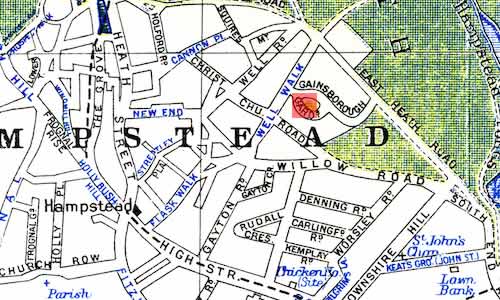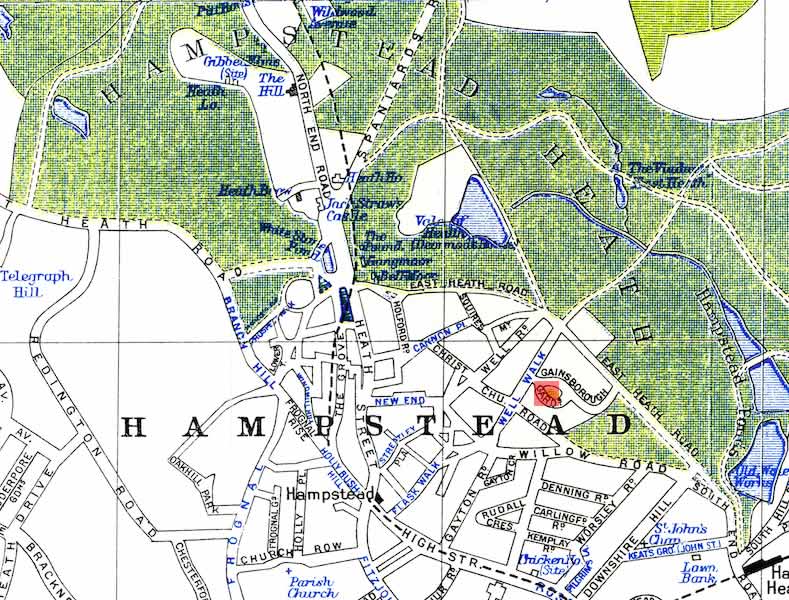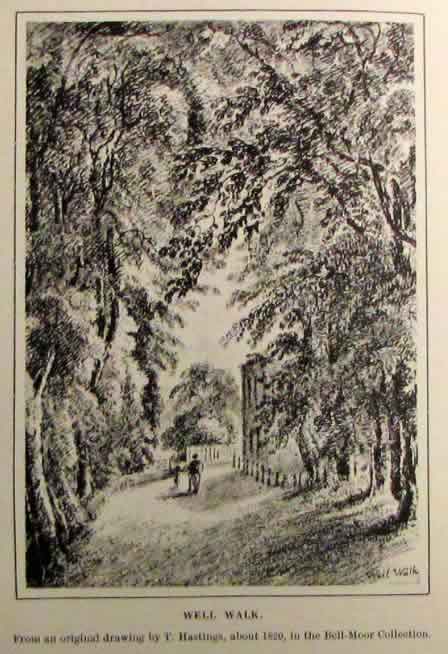March 1817: Hunt & Haydon as Keats’s Mentors; Toward Endymion
1 Well Walk, Hampstead


Where, toward the end of March, Keats (aged twenty-one) rents rooms with his younger brothers, George and Tom.
Being in Hampstead puts Keats a suburban milieu and coterie close to Leigh Hunt, who, beginning October 1816, encourages and unofficially mentors Keats, which is not surprising given Hunt’s reputation as a poet, critic, and celebrity journalist—and co-editor of the liberal paper, The Examiner.
[*See here for a graph of Keats’s network based on part of this coterie, with Hunt as a significant if not crucial hub.]
In the last four months, Hunt has published five
of Keats’s poems in The Examiner, and so connection with
Hunt has some advantages for young and ambitious Keats. Association with Hunt will,
however,
peg Keats as a certain kind of writer and thinker, and completely at odds with Tory
critics
and tastes. Later in this year, in October, Hunt will be nastily nominated as the
pretentious
Doctor and Professor
of the Cockney School
of poetry (in Blackwood’s Edinburgh Magazine), and by August 1818, Keats will
be disparagingly joined to Hunt as his naive and ineffectual follower. By then, Keats’s
writing and poetics are purposefully moving beyond the scope of Hunt’s poetic influence—not
to
mention beyond Hunt’s poetic capabilities. But, for now, Keats will first have to
break away
from some of Hunt’s poetic traits, like feminine rhymes and adjectival daintiness.
He will
also have to evolve subjects less occasional and a voice less motivated by sociability;
this
begins to take place as Keats very deliberately studies great poetry, great art, and
important
literary criticism.
Since October 1816, and mainly through Hunt, Keats has quickly become friends with a network of artists, writers, critics, publishers, and other poets, all of whom begin to both prompt and challenge Keats’s ideas and aspirations. One of those new acquaintances Keats meets almost immediately via Hunt is the historical artist Benjamin Robert Haydon, and in early March, Keats sees the Elgin Marbles with Haydon. What Keats encounters profitably sticks with him, and the experience immediately triggers thoughts about weighted mortality in the face of immortal art and beauty, which is a subject to which some of Keats’s greatest poetry will, within a few years, return; but we see the topic signaled in two of Keats’s (thus far) better poetic efforts, both of which are published on 9 March: On Seeing the Elgin Marbles, and To Haydon with a Sonnet Written on Seeing the Elgin Marbles. Keats will also become intrigued by how art, though silent, possesses lasting power through its beauty alone.
Keats’s connection with Haydon is, at this point, intimate and mutually enthusiastic: as
Haydon writes to Keats this month, he vividly believes that Keats sympathetically
recognizes
his own talents and that burning ripeness of soul
: you add fire, when I am
exhausted, & excite fury afresh—I offer my heart & intellect & experience.
Haydon made a life-mask of Keats in December 1816, and he will also include Keats
in one of
his large historical canvases.
In March, Keats also writes a poem on Hunt’s poem,
The Story of Rimini. Keats’s sonnet—On The Story of Rimini—praises
Hunt’s sweet tale
with its bower-invoking delights.
As mentioned, Hunt and his
poetry openly influence Keats’s earlier work—Hunt at this point still hovers as a
kind of hero
and model for Keats—but, at least on one level, this is not necessarily a good thing:
in terms
of poetic style, Keats will have to move well beyond Hunt’s affected poeticisms and
use of
wispy description for description’s sake, entertaining though for some it might be.
Neither
professionally nor dispositionally is Keats like Hunt, though he is naturally impressed
by
Hunt’s amiability, reputation, energies, and connections, as well as his dedication
to
reformist political causes and to poetry. Hunt, for his part, will, even after Keats’s
death,
peg him as the beautiful young poet, and Hunt in fact seems to particularly like Keats’s
poetry when it sounds a little like his own, as when he praises a line in one of Keats’s
poems
as possessing delicate modulation, and super-refined epicurean nicety!
(from Hunt’s
essay on Keats in The English Poets, in vol. 4 of Hunt’s
complete works [1856], p.248).

During March, Keats sees his Poems collection published, the official ending of his position of surgeon at Guy’s hospital, poetry published in The Examiner, a strong review of Poems by his friend John Hamilton Reynolds in The Champion, and positive notice of his Poems in The New Monthly Magazine. Keats has to pay for the cost of publishing his collection to the Ollier brothers, Charles and James, who hope to make some capital from the project in the form of commission to help support their new company: the title page of Poems cites the printer as C. & J. OLLIER, 3, WELBECK STREET, / CAVENDISH SQUARE. There is also a quotation from Spenser on the page (Keats’s first poetical model) and an image of Shakespeare, though sometimes mistaken as Spenser. Probably upon the publication Poems, Keats and Hunt crown themselves with bardic laurel wreathes and celebrate the occasion by writing poems.
Besides being thrilled about all of this, no doubt Keats at this moment starts to
become more
conscious of his own poetic directions and tastes, especially given his awareness
that Poems is a bare step above juvenilia—a few years later, when he is
sick and all his writing behind him, Keats will refer back to this early poetry as
his
first-blights
(letters, 16 Aug 1820). Conversations with the likes of Hunt and Haydon, as well as with Reynolds and
the volatile young poet Percy Shelley and his
wife, Mary (in December and over into February),
can only have led Keats to reflect on the poet he hopes to become and the poetry he
hopes to
write. Plaguing Keats’s poetic progress are notions of fame and the poetry of occasion
and
sociability, often encouraged by Hunt. Keats might also have had thoughts about the
poetic
inclinations of Shelley, Hunt’s other apparent disciple. But Shelley’s reformist and
radical
politics, which are never far from the surface, does not strike a chord with Keats’s
more
filtered and pure literary aspirations. Keats will strive less for immediate relevance
than
for lasting capabilities. To elaborate and repeat: association with Hunt bogs down
Keats’s
reception in (or reduces it to) partisan politics, and though Keats’s natural ideological
sympathies largely correspond with those of Hunt, Keats’s values, beliefs, and judgments
increasingly focus on how to represent art’s truth and beauty in the context of imaginative
capabilities and human mortality. While of course everything can be reduced to (or
critically
forced into) the political, such reduction is in fact what Keats hopes to transcend
in his
poetry, and what motivates the kind of greatness Keats desires to achieve.

Near the Well Walk Hampstead,1828, by Thomas Hasting (British Museum)
Resolve to write a long and testing poem grows. Haydon advises Keats that he needs to be alone in order to improve
himself
(letters, 17 March), which marks a move away from Hunt’s sway. Keats heads out on his writing trip (to the Isle of Wight) to work on a
poem that, as a kind of self-imposed apprenticeship, will test his poetic resolve
and
resources—proof that he is a real poet. And so by the end of the third week of April,
and
after moving on to Margate, Keats will have begun his mythological romance, Endymion. Close to a year later, Keats is finally done with the
4,050-line poem. It will be published as a stand-alone volume, appearing April 1818
(and not
published by the Olliers, but by his new
publishers, Taylor & Hessey). Upon completion, Keats is very glad to have the poem
behind him. All at the same time, the poem acts as a stepping-stone, a trial, a test
of
endurance and commitment, and something to, as it were, get out of his system.
Although the dating is somewhat uncertain, Keats composes two indifferent sonnets
about a
laurel crowing moment: On Receiving a Laurel Crown from
Leigh Hunt and To the Ladies Who Saw Me
Crown’d; Hunt in a way anticipates the idea in a earlier sonnet of his own, To
John Keats,
written on the day—1 December 1816—he publishes an article about Young
Poets
in The Examiner: the poem ends by Hunt writing that he sees a
flowering laurel
on young Keats’s brow,
with the word brow
almost
certainly picking up on its use in Keats’s thus-far most memorable poem, On First
Looking into Chapman’s Homer, which pictures Homer’s legistlating poetic power.
Keats’s dress is, at this point, apparently somewhat non-conventional and offbeat, perhaps signalling a new sense of persona. He sees himself as a cool, young poet—which, of course, is what he is. An open collar is a give-away.

